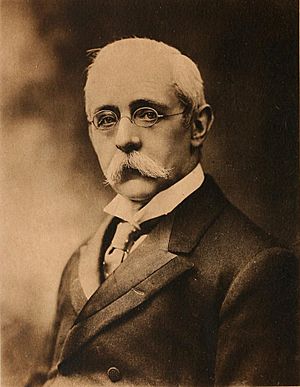Herbert Giles facts for kids
Quick facts for kids
Herbert Giles
翟理斯 |
|||||||||||||||||||||
|---|---|---|---|---|---|---|---|---|---|---|---|---|---|---|---|---|---|---|---|---|---|
 |
|||||||||||||||||||||
| Born |
Herbert Allen Giles
8 December 1845 Oxford, England
|
||||||||||||||||||||
| Died | 13 February 1935 (aged 89) Cambridge, England
|
||||||||||||||||||||
| Nationality | British | ||||||||||||||||||||
| Known for | Wade–Giles romanization | ||||||||||||||||||||
| Awards | Order of Chia-Ho | ||||||||||||||||||||
| Scientific career | |||||||||||||||||||||
| Institutions | University of Cambridge | ||||||||||||||||||||
| Chinese name | |||||||||||||||||||||
| Chinese | 翟理斯 | ||||||||||||||||||||
| Wade–Giles | Chai2 Li3-ssŭ1 | ||||||||||||||||||||
| Hanyu Pinyin | Zhái Lǐsī | ||||||||||||||||||||
|
|||||||||||||||||||||
Herbert Allen Giles (born December 8, 1845 – died February 13, 1935) was an important British expert on China. He was a diplomat (someone who represents their country abroad) and a sinologist (a scholar who studies China). For 35 years, he was a professor of Chinese at the University of Cambridge.
Giles went to Charterhouse School before working as a diplomat in China. He is famous for changing a system used to write Chinese sounds in English letters. This system, called Wade-Giles, is still known today. He also translated many important Chinese books. These include the Analects of Confucius, the Tao Te Ching, and the Chuang Tzu. In 1892, he published a very important book called A Chinese-English Dictionary.
Contents
About Herbert Giles
Herbert Allen Giles was the fourth son of John Allen Giles, who was a clergyman. After studying at Charterhouse School, Herbert became a British diplomat in Qing China. He worked there from 1867 to 1892.
He also spent several years in northern Taiwan, from 1885 to 1888. He was the British Consul (a type of diplomat) in Tamsui during this time. Before that, in 1869, Giles was based in Kaohsiung.
In 1870, he married Catherine Maria Fenn. They had six children: Bertram, Valentine, Lancelot, Edith, Mable, and Lionel Giles. His son, Lionel, also became an expert on China.
Professor at Cambridge
In 1897, Herbert Giles became the second professor of Chinese language at the University of Cambridge. He took over from Thomas Francis Wade, who had started the Chinese writing system Giles later improved. At that time, Giles was the only expert on China at Cambridge. This meant he could spend his time reading and translating old Chinese texts.
Giles wrote more than sixty books, lectures, and articles. He spent over fifteen years creating his large Chinese-English Dictionary. This dictionary became a key reference book for many years. He also wrote the first history of Chinese literature and art. Some of his translations are still considered excellent today.
Herbert Giles was known for speaking his mind. He often criticized the work of other scholars. He also spoke out about how Chinese travelers were treated on British ships. Even though he could be tough, people who knew him said he was very charming.
He worked with his son, Dr. Lionel Giles, on some of his books. Lionel was also a China expert and worked at the British Museum.
Later Life and Works
Later in his life, Giles wrote a history of Chinese art in 1905. He also gave lectures on Confucianism in 1914, which were published as a book. He dedicated the third edition of his book Strange Stories from a Chinese Studio (1916) to his seven grandchildren.
Herbert Giles was married twice. His first wife was Catherine Maria Fenn. His second wife was Elise Williamina Edersheim, who passed away in 1921. Elise was also a writer. She wrote China Coast Tales under the name Lise Boehm.
In 1922, the Royal Asiatic Society gave Giles their Triennial Gold Medal. His friend, Lionel Charles Hopkins, said that Giles had helped more people learn about China than any other scholar. He made Chinese studies more understandable for everyone.
Giles retired in 1932 and died in Cambridge in 1935, at the age of 89.
His Legacy
Giles received the Prix Julien award from the French Academy in 1897 for his Chinese Biographical Dictionary.
His Chinese-English Dictionary is very important. It is seen as a key book in the history of Chinese-English dictionaries. It was the main source for the Wade-Giles system of writing Chinese sounds.
In 1917, Giles started an award called the Prix Giles. This award gives money to a French person every two years. It is given for a work they have written about China, Japan, or East Asia.
Diplomatic Work
Here are some of the places Herbert Giles worked as a British diplomat:
- British Vice Consul at Pagoda Island, Mawei (1880–1883)
- British Vice Consul at Shanghai (1883–1885)
- British Consul at Tamsui (1885–1891)
- British Consul at Ningpo (1891–1893)
Awards and Honours
Herbert Giles received many awards and honours for his work:
- Order of Chia-Ho
- Gold medal from the Royal Asiatic Society
- Prix St. Julien from the French Academy (twice)
- Honorary degrees from the University of Aberdeen (1897) and University of Oxford (1924)
See also
 In Spanish: Herbert Giles para niños
In Spanish: Herbert Giles para niños

